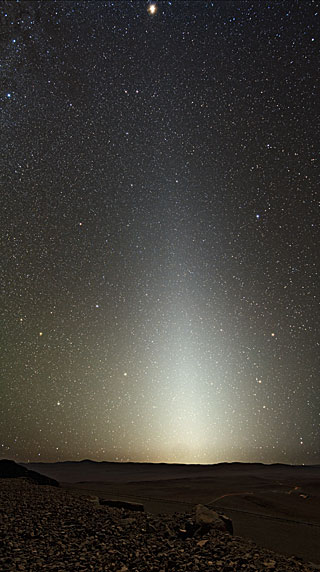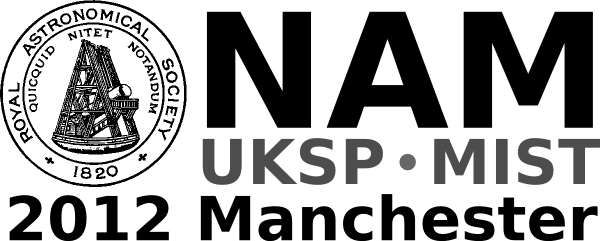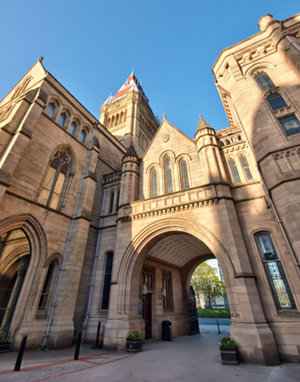UK-Germany National Astronomy Meeting NAM2012
CODITA: measuring the cosmic dust swept up by the Earth
Royal Astronomical Society press release
RAS PR 12/33, NAM 24
Friday 30 March 2012

A glorious starry sky, with a bright column due to zodiacal light, illuminates the desert landscape around Cerro Paranal, home to ESO's Very Large Telescope (VLT).
Although we think of space as being empty, there is more out there than meets the eye - dust, for example, is everywhere. If all the material between the Sun and Jupiter were compressed together it would form a moon 25 km across. Now a new research programme will try to see how much of this dust enters the Earth's atmosphere. Metals from the cosmic dust play a part in various phenomena that affect our climate. An accurate estimate of dust would also help us understand how particles are transported through different layers of the Earth's atmosphere. Professor John Plane of the University of Leeds will present the Cosmic Dust in the Terrestrial Atmosphere (CODITA) project on Friday 30 March at the National Astronomy Meeting in Manchester.
CODITA has received a EUR 2.5 million grant from the European Research Council to investigate the dust input over the next 5 years. The international team, led by Professor Plane, is made up of 11 scientists in Leeds and a further 10 research groups in the US and Germany.
The main sources of dust in the Solar system are collisions between asteroids and material evaporating off comets as they approach the Sun. When dust particles approach the Earth they enter the atmosphere at very high speeds, anything from 38 000 to 248 000 kilometres an hour, depending on whether they are orbiting in the same direction or the opposite to the Earth's motion around the Sun.
The particles undergo very rapid heating through collisions with air molecules, reaching temperatures well in excess of 1600 degrees Celsius. At this point they melt and evaporate. Particles with diameters greater than about 2 millimetres give off enough material to produce visible meteors, or "shooting stars". But most of the mass of dust particles entering the atmosphere are much smaller than this, so can be detected only using specialised meteor radars.
"We have a conundrum - estimates of how much dust comes in vary by a factor of a hundred," said Plane. "The aim of CODITA is to resolve this huge discrepancy."
Satellite observations suggest that 100-300 tonnes of cosmic dust enter the atmosphere each day. This figure tallies with the rate of accumulation in polar ice cores and deep-sea sediments of rare elements linked to cosmic dust, such as iridium and osmium. However, measurements in the earth's atmosphere indicate that the input could be as low as 5 tonnes per day. These measurements include meteor radar observations, laser observations of the sodium and iron atoms from evaporating dust in the upper atmosphere, and measurements by high altitude aircraft of meteoritic iron in the lower stratosphere.
"If the dust input is around 200 tons per day, then the particles are being transported down through the middle atmosphere considerably faster than generally believed; if the 5-tonne figure is correct, we will need to revise substantially our understanding of how dust evolves in the Solar System and is transported from the middle atmosphere to the surface," said Plane.
The metals injected into the atmosphere from evaporating dust particles are involved in a diverse range of phenomena linked to climate change.
"Cosmic dust is associated with the formation of 'noctilucent' clouds - the highest clouds in the Earth's atmosphere. The dust particles provide a surface for the cloud's ice crystals to form. These clouds develop during summer in the polar regions and they appear to be an indicator of climate change,' said Plane. "The metals from the dust also affect ozone chemistry in the stratosphere. The amount of dust present will be important for any geo-engineering initiatives to increase sulphate aerosol to offset global warming. Cosmic dust also fertilises the ocean with iron, which has potential climate feedbacks because marine phytoplankton emit climate-related gases."
The CODITA team will also use laboratory facilities to tackle some of the least well-understood aspects of the problem
Plane explained, "In the lab, we'll be looking at the nature of cosmic dust evaporation, as well as the formation of meteoric smoke particles, which play a role in ice nucleation and the freezing of polar stratospheric clouds. The results will be incorporated into a chemistry-climate model of the whole atmosphere. This will make it possible, for the first time, to model the effects of cosmic dust consistently from the outer Solar System to the Earth's surface."
IMAGES
Light scattered by the Zodiacal dust cloud, as seen from Paranal (Chile). This photograph was produced by the European Southern Observatory. Credit: ESO/Y.Beletsky http://www.eso.org/public/images/yb_zodiacal_light_paranal_cc/
MEDIA CONTACTS
NAM 2012 Press Office (0900 - 1730 BST, 27-29 March; 0900 - 1630 BST 30 March)
Room 3.214
University Place building
University of Manchester
Manchester
UK
Tel: +44 (0)161 306 7313
Dr Robert Massey
Royal Astronomical Society
Mob: +44 (0)794 124 8035
Email: rm@ras.org.uk
Anita Heward
Royal Astronomical Society
Mob: +44 (0)7756 034 243
Email: anitaheward@btinternet.com
Dr Klaus Jaeger
Pressereferent / Press Officer im Vorstand der Astronomischen Gesellschaft
Tel: +49 6221 528 379
Email: pressereferent@astronomische-gesellschaft.de
Dan Cochlin
Media Officer (Faculty of Engineering and Physical Sciences)
University of Manchester
Tel: +44 (0)161 275 8387
Email: daniel.cochlin@manchester.ac.uk
SCIENCE CONTACTS
John Plane
Professor of Atmospheric Chemistry
University of Leeds
Tel: +44 (0)113 3438044
Email: J.M.C.Plane@leeds.ac.uk
NOTES FOR EDITORS
NAM 2012
Bringing together more than 900 astronomers and space scientists, the National Astronomy Meeting (NAM 2012) will take place from 27-30 March 2012 in the University Place conference centre at the University of Manchester in the UK. The conference is a joint meeting of the Royal Astronomical Society (RAS) and the German Astronomische Gesellschaft (AG) and is held in conjunction with the UK Solar Physics (UKSP: www.uksolphys.org) and Magnetosphere Ionosphere Solar Terrestrial (MIST: www.mist.ac.uk) meetings. NAM 2012 is principally sponsored by the RAS, AG, STFC and the University of Manchester.
The Royal Astronomical Society
The Royal Astronomical Society (RAS: www.ras.org.uk), founded in 1820, encourages and promotes the study of astronomy, solar-system science, geophysics and closely related branches of science. The RAS organises scientific meetings, publishes international research and review journals, recognizes outstanding achievements by the award of medals and prizes, maintains an extensive library, supports education through grants and outreach activities and represents UK astronomy nationally and internationally. Its more than 3500 members (Fellows), a third based overseas, include scientific researchers in universities, observatories and laboratories as well as historians of astronomy and others.
The Astronomische Gesellschaft (AG)
The Astronomische Gesellschaft (AG: www.astronomische-gesellschaft.de), founded in 1863, is a modern astronomical society with more than 800 members dedicated to the advancement of astronomy and astrophysics and the networking between astronomers. It represents German astronomers, organises scientific meetings, publishes journals, offers grants, recognises outstanding work through awards and places a high priority on the support of talented young scientists, public outreach and astronomy education in schools.
The Science and Technology Facilities Council
The Science and Technology Facilities Council (STFC: www.stfc.ac.uk) is keeping the UK at the forefront of international science and tackling some of the most significant challenges facing society such as meeting our future energy needs, monitoring and understanding climate change, and global security. The Council has a broad science portfolio and works with the academic and industrial communities to share its expertise in materials science, space and ground-based astronomy technologies, laser science, microelectronics, wafer scale manufacturing, particle and nuclear physics, alternative energy production, radio communications and radar. It enables UK researchers to access leading international science facilities for example in the area of astronomy, the European Southern Observatory.
Jodrell Bank Centre for Astrophysics
The Jodrell Bank Centre for Astrophysics (JBCA: www.jb.man.ac.uk) is part of the School of Physics & Astronomy at the University of Manchester. JBCA is split over two main sites: the Alan Turing Building in Manchester and the Jodrell Bank Observatory in Cheshire. At Jodrell Bank Observatory, the new Jodrell Bank Discovery Centre is a key focus for our work in public engagement and education. Jodrell Bank is a world leader in radio astronomy-related research and technology development with a research programme extending across much of modern astrophysics. The group operates the e-MERLIN national radio astronomy facility and the iconic Lovell Telescope, hosts the UK ALMA Regional Centre Node and is home to the international office of the SKA Organisation. Funded by the University, the Science & Technology Facilities Council and the European Commission, it is one of the UK's largest astrophysics research groups.





